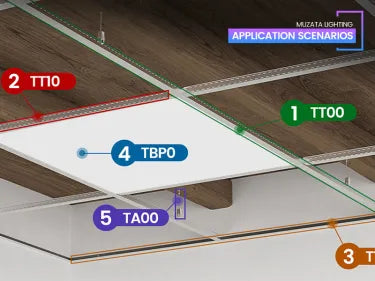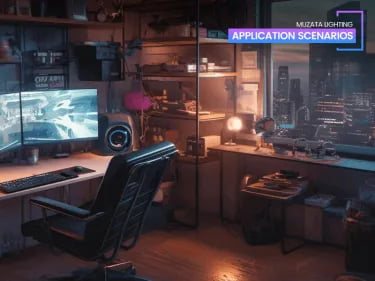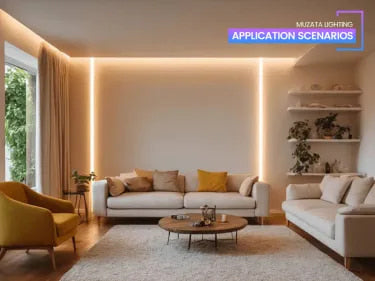TABLE OF CONTENTS
Can You Put LED Strip Lights In Shower?

In the quiet solitude of the shower room, you stand under the warm cascade of water, enveloped in a cloud of steam. As the water trickles down your body, you reach for the bar of soap, its gentle scent wafting through the air, creating a soothing lather that cleanses away the remnants of the day.
Can You Install LED Strip Lights in the Shower?

Can You Install LED Strip Lights in the Shower?
Yes, you can install LED strip lights in the shower. I mean, why not install waterproof lights for shower? They are super practical.
Some waterproof lights for showers are very waterproof and the bathroom LED strip lights can withstand exposure to moisture. Otherwise, you can purchase an LED channel to protect the bathroom LED strip lights. This makes them suitable for use in wet areas such as showers.

Waterproof lights for shower
Worth Installing LED Strip Lights in the Shower?
Of course, shower LED strip lights are energy-efficient and provide a steady source of lighting. This means that you can avoid having to deal with flickering or dim bulbs, which can be frustrating and dangerous when you're in the shower.

You can also add a touch of style and sophistication to transform your shower ambiance by installing bathroom LED strip lights. With various color options and customizable settings, you can create a relaxing or invigorating atmosphere that complements your personal taste and mood.
What Kind of LED Strip Lights Suit In Shower Room Lights?
If you really want to install bathroom LED strip lights for your shower room and value safety, you definitely need to purchase those that are specifically designed to be waterproof. These bathroom LED strip lights are made with special materials that can withstand exposure to moisture and humidity, making them safe to use in wet areas such as showers.
When choosing LED strip lights for your shower room, you should look for those that have an IP rating of at least 65 or higher. The IP rating indicates the level of protection against dust and water, with higher numbers indicating greater protection. An IP65 rating, for example, means that the waterproof lights for shower lights are protected against dust and water jets from any direction. Check Wikipedia for more on IP ratings >>.
Muzata IP65 Waterproof LED Strip Lights
Where to Install LED Strip Lights in the Shower?
Bathroom Lighting Ideas1: Shower Area Lights
Installing bathroom LED strip lights around the perimeter of the shower or within niches can create a relaxing ambiance and improve visibility. To ensure durability and safety, it is crucial to use bathroom LED strip lights with an IP65 rating or higher, which indicates protection against water jets and moisture.

Bathroom LED Lights Installation Tips for Shower Area Lights
-
Perimeter Lighting
Mount the bathroom LED strip lights along the top or bottom edges of the shower walls. This placement not only enhances visibility but also adds a touch of luxury to your shower experience.
-
Niche Lighting
Installing LED strips in shower niches can highlight architectural features and provide functional lighting for toiletries. Ensure the strips are firmly secured and sealed to prevent water ingress.
-
Sealing and Protection
Use silicone sealant to protect the connections and ends of the bathroom LED strips. This prevents water from seeping into the electrical components, ensuring longevity and safety.
Bathroom Lighting Ideas2: Shower Niche Lights
Highlighting niches with bathroom LED strip lights can add a touch of elegance and provide functional lighting for storing toiletries. Choosing waterproof LED strips lights for shower is essential to prevent damage from moisture and to maintain a sleek appearance.

Bathroom Light Installation Tips for Bathroom Niche
-
Design and Measurement
Measure the niche dimensions accurately to ensure a snug fit for the LED strips. Plan the placement to highlight the niche effectively.
-
Mounting Method
Use adhesive backing or mounting clips to secure the LED strips. Ensure the surface is clean and dry before applying the adhesive.
-
Waterproofing
Protect the LED strips and connections with waterproof connectors and silicone sealant. This step is crucial to prevent moisture damage and ensure safe operation.
Bathroom Lighting Ideas3: Shower Ceiling Lights
LED strip lights can be installed along the edges of the ceiling or in recessed areas to provide indirect lighting. This method offers a soft, ambient glow that brightens the entire bathroom without harsh glare, creating a spa-like atmosphere.

Bathroom Light Installation Tips for Bathroom Ceiling
-
Edge Lighting
Install LED strips along the edges of the ceiling to create a floating ceiling effect. This enhances the room’s aesthetics and provides even lighting.
-
Recessed Lighting
For a modern look, install the LED strips in recessed channels or coves. This setup hides the strips while allowing the light to diffuse softly across the ceiling.
-
Securing the Strips
Use strong adhesive or mounting clips to secure the LED strips. Clean the surface thoroughly to ensure proper adhesion.
Bathroom Lighting Ideas4: Vanity Mirror Shower Lights
Placing LED strip lights around the vanity mirror can enhance your grooming experience by providing even, shadow-free lighting. Ensure the strips are appropriately rated for use in damp conditions to maintain safety and functionality.

Bathroom Light Installation Tips for Vanity Mirror
-
Mirror Frame
Attach the LED strips to the back of the mirror frame or around its edges. This creates a halo effect that provides ample lighting for grooming tasks.
-
Even Illumination
Position the strips evenly to avoid shadows. Consider using diffusers to soften the shower light and ensure an even spread.
-
Damp Rating
Choose LED strips with a damp location rating to withstand the bathroom's humidity levels. This prevents electrical issues and extends the life of the shower lights.
Something About Installation LED Strip Lights In Shower
People Who Can Install LED Strip Lights in Their Shower Room:
-
DIY enthusiasts
If you have experience with electrical installations and feel confident working with wiring and fixtures, you may consider installing LED strip lights in your shower room. However, it is still important to adhere to safety guidelines and local regulations. (Occupational Safety and Health Administration (OSHA).)
-
Homeowners
As a homeowner, you have more flexibility in making modifications to your property. If you own your home, you can make decisions regarding its aesthetics and functionality, including installing LED strip lights in the shower room.
People Who Should Avoid Installing LED Strip Lights in Their Shower Room:
-
Individuals without electrical knowledge
If you lack experience or knowledge about electrical installations, it is advisable to hire a professional electrician. Working with electricity without proper knowledge can be dangerous and potentially lead to accidents or damage.
-
Renters or tenants
If you are renting a property or living in a space where modifications are not allowed, it is best to consult with your landlord or property manager before installing LED strip lights in the shower room. They may have specific rules or regulations in place that prohibit such installations.
Bathroom Light Installation Tips
1. Plan Your Layout
Before installation, meticulously plan where you want to place the LED strip lights. Measure the areas accurately and determine the required length of the LED strips. Consider factors like proximity to power sources, the visibility of the strips, and the overall aesthetic you wish to achieve.
Detailed Planning Steps:
-
Sketch a Layout
Draw a detailed plan of your bathroom, marking where each LED strip will be installed. Include measurements and note any obstacles or fixtures.
-
Check Power Sources
Identify the locations of power outlets and plan the placement of LED strips accordingly. Ensure there are convenient and safe power sources nearby.
-
Consider Visibility
Decide if you want the LED strips to be visible or hidden. For a sleek look, consider installing the strips in recessed areas or behind moldings.
2. Choose the Right Power Supply
Ensure you have a compatible power supply for your LED strip lights. The power supply should match the voltage and wattage requirements of the strips. For example, a 5-meter strip might require a 12V DC power supply with a wattage of 60 watts.

Power Supply Selection Tips:
-
Calculate Total Wattage
Add up the wattage of all the LED strips to ensure your power supply can handle the load. For safety, choose a power supply with at least 20% more wattage than required.
-
Voltage Matching
Verify that the voltage of the power supply matches the LED strips (e.g., 12V strips with a 12V power supply).
-
Waterproof Power Supplies
For installations in damp areas, use waterproof power supplies to prevent electrical hazards.
3. Proper Adhesion
Clean the installation surface thoroughly to ensure the adhesive backing of the LED strips sticks properly. Use additional mounting clips if necessary, especially in humid areas.

-
Surface Preparation
Clean the surface with isopropyl alcohol to remove dirt and grease. Allow it to dry completely before applying the adhesive.
-
Additional Support
In high-moisture areas, use mounting clips or brackets to provide extra support. This prevents the strips from sagging or detaching over time.
- Pressure Application
Press firmly along the length of the strip to ensure good contact with the surface.
4. Waterproof Connections
Use waterproof connectors and silicone sealant to protect the electrical connections from moisture. This step is crucial for maintaining the safety and longevity of the LED strip lights.
-
Waterproof Connectors
Use connectors specifically designed for waterproof LED strips. These connectors seal the ends and prevent water ingress.
-
Sealant Application
Apply silicone sealant around all connections and exposed ends. This provides an extra layer of protection against moisture.
-
Heat Shrink Tubing
Use heat shrink tubing over connections for additional waterproofing and to keep connections secure.
5. Test Before Final Bathroom Light Installation
Connect and test the LED strip lights before final installation. This ensures all connections are secure and the shower lights function correctly.
-
Temporary Setup
Connect the LED strips to the power supply temporarily and test all connections. Ensure the shower lights work correctly and there are no flickers or dim areas.
-
Functionality Check
Test all features, such as dimming and color changes, to ensure everything works as expected.
-
Final Adjustment
Make any necessary adjustments before securing the strips permanently. This saves time and effort compared to making changes after installation.
Recommended Reading
Are LED Strip Lights Waterproof?
How Do You Light Up a Game Room?
Can I Put LED Lights on Drywall?
Choosing the Best LED Lights for Your Garage - What You Need to Know
LED Bathroom Lights Make Your Bathroom Lighting Shine Bright
ABOUT THE AUTHOR





